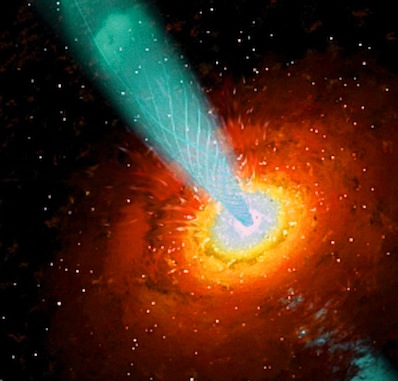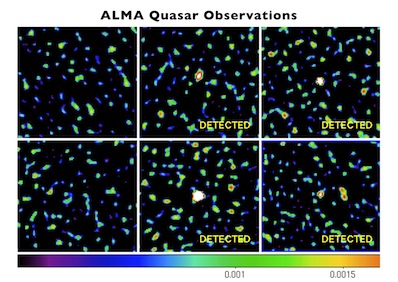



|

|

Starving galaxies shut down star formation
DR EMILY BALDWIN
ASTRONOMY NOW
Posted: 13 January 2012


Astronomers using the partially built ALMA (Atacama Large Millimetre/submillimetre Array) observatory have, for the first time, caught a group of galaxies changing from active star building factories into red, dead ellipticals.

Jets from a black hole blast away star forming gases, preventing the galaxy from creating new stars. Image: Wolfgang Steffen, Cosmovision; Marscher et al., NRAO/AUI/NSF.
Astronomers have long thought that collisions between spiral galaxies ultimately create large elliptical galaxies which possess few young stars. During such a violent collision gas and dust slams together, sparking a burst of star formation and sending some stars flying headlong into the jaws of the supermassive black hole that lurks at the heart of the merged galaxies. Powerful jets are burped out from the black hole, lighting it up as a brilliant quasar. Over time, these jets are thought to blow away the gas that might have otherwise been used to create new stars.
The new ALMA observations, made during the first three months of the observatory's science operation phase, reveal the connection of this critical jetting stage to the cessation of star formation by observing, well, nothing, in what should be active galaxies.
“Despite ALMA’s great sensitivity to detecting starbursts, we saw nothing, or next to nothing – which is exactly what we hoped it would see,” says lead investigator Carol Lonsdale of the North American ALMA Science Center at the National Radio Astronomy Observatory (NRAO) in Virginia, who told attendees of the 219th American Astronomical Society meeting this week that there was little to no tell-tale dust present in observations of two dozen galaxies. “ALMA’s results reveal to us that there is little-to-no starbursting going on in these young, active galaxies. The galaxy evolution model says this is thanks to their central black holes whose jets are starving them of star-forming gas.”

Selected images of the quasars observed so far by ALMA. Only 11 out of 23 were detected, the remaining 12 were barely visible against the background noise, meaning that there is very little evidence for dust warmed by star formation, providing evidence that the central jets are starving the galaxy of star-forming ingredients. Image: C. Lonsdale, NRAO/AUI/NSF; ALMA (NRAO/ESO/NAOJ).
Once all the ingredients for making new stars has been ejected from the galaxy, the last generation of short-lived blue star dies out, leaving the long-living, lower mass red stars to dominate.
“ALMA revealed to us this rare stage of galaxy starvation, and now we want to use the Very Large Array (VLA) to focus on delineating the outflows that robbed these galaxies of their fuel,” says Lonsdale. “Together, the two most sensitive radio telescope arrays in the world will help us truly understand the fate of spiral galaxies like our own Milky Way.”

ALMA is still being built at the 5,000 metre altitude site in the Atacama Desert. Image: Emily Baldwin.
The candidate galaxies were first picked out by NASA’s Wide-field Infrared Survey Explorer (WISE) spacecraft, and compared with NRAO’s VLA Sky Survey of 1.8 million radio objects. Those with overlapping results were followed-up by ALMA, which can discriminate between dust warmed by starburst activity and dust heated by material falling onto the central black hole. ALMA astronomers have 26 more WISE quasars to probe before publishing their results more formally later this year.
“On its first run out of the gate, ALMA confirmed a critical phase in the timeline of galaxy evolution,” adds Lonsdale.
|

|

|

|
|



